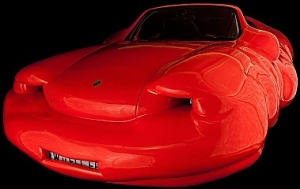The Unmaking of Conceptual Art
2012/03/12 § 11 Comments
I haven’t been writing a great deal over the last five or so years as I have tried my hand at sculpture. In particular with lost-wax processes, making figures in bronze and pewter.
Over the last year I have been working at MONA since it opened in January 2011 as an invigilator or gallery attendant. I get paid to enhance the visitor experience while MONAISM evolves around me, but mostly I people watch.
And think.
With regard to format, the focus of this blog, at work I think about conceptual art, the end of conceptual art, the death of conceptual art.
It’s a slow death, or a slow food fight at the wake.
I could write a manifesto about what movement is going to replace it, but the manifesto as a format is more of a joke-book these days, so I’ll let that go.
It’s dying for reasons that have very little to do with art. Art in the sense of the art world/market/institutions, or even artists.
Particularly Artists.
It’s ending because, well, process is returning, and for reasons mostly to do with the coming of the home-based replicator, i.e. the 3D printer or additive manufacturing.
We are all going to be able to make things we used to have made in factories, and cheaply, the result is that more people will be aware of the process of making something, even if our children think yoghurt grows on trees.
In some measure I can’t predict it is also the end of Art, but Conceptual Art is definitely over. It can’t be measured because Conceptual Art has become a singularity, a black hole sucking everything else up. Hurrah for 3D printing!
Thus the Museum of Old and New Art, provides the memorial to Conceptual Art. This memorializing is a by-product to the motives of the place, which are to showcase the collection for investment purposes, and to share that collection with Tasmanians as an enlightenment project.
It is a mighty fine memorial. No other memorial need now be built to commemorate the end of Conceptual Art.
_________________
The old art in the museum is Art because, well, that is what people who collect it— call it. Antiquities and other mathoms what look real pretty; coins, flints and sarchophagi.
This is my favourite.

Altar in the form of a bird-headed deity Golan Heights, Syria, Chalcolithic, 4000–3000 BCE (I reckon vulture.) MONA
The new art is mostly collectible modern art since WW2 (not being collectible or to be found in the pages of KUNSTFORUM I’m not featured at MONA).
Now while none of the collection’s older contents as I’ve described them so far mean they are Conceptual Art, they do involve concepts. (Some claim conceptual elements in fancy paleolithic axes.) For example, take a look at some of the old stuff, e.g. a profile on an old coin from one of the Greek cities of Bactria.
Some powerful dude tells the artisan what to put on their portrait. “I need an elephant on my head so the people of the Indus respect my power more and get reminded of it when they spend their money.”
The artisan says, “sure thing dude.”

Tetradrachm of Demetrius I Bactria, Paropamisadae and Arachosia, Greco-Bactrian kingdom, c. 200–190 BCE Silver MONA
As economies grow such direct curatorial patronage is replaced by more collecting-orientated art markets (this takes thousands of years) where middle class pretensions become more and more important. Where once the artisan is an Artist only so far as they can get away with their own interpretations, comment or ‘license’ in glorying their Lords and Pontiffs, the Artist now is expected to provide their own arguments. They must recognize their own place in the (anti-)tradition, or be labelled naive. In that recognition they offer up some conceptual framework and thus, finally, deep in the noosphere, the excuses for the making of the art, or Art. (More latterly we can blame the Art School and their traditional requirements and excuses to fulfill academic degree programmes for these sacrifices.)
Obviously we could outline all the stages in between the two and talk about the aesthetic assumptions of the Mannerists compared to the nihilistic axiological concerns of the Dadaists. And then talk about progress, or, better, talk about the evolution of complexity which is not yet evenly distributed.
But MONA doesn’t bother with the middle bit, so neither shall I. It just gets in the way.
It would distract from my claim that all art is conceptual in conception, even when the artist take liberties with the commission.
 Not at MONA.
Not at MONA.The Confraternity of the Immaculate Conception, a lay brotherhood, in 1483 commissioned Leonardo da Vinci in a lengthy contract, Leonardo paint the central panel dedicated to the promulgation of the doctrine of the Immaculate Conception. The Virgin was to be “portrayed to perfection” in a gown of gold brocade and deep blue, lined in green. Similarly attired, God the Father was to be depicted overhead, while angels with golden haloes would be painted “in the Greek manner.” Flanked by two prophets, the Virgin was to be presented without her child.
Conceptual Art is over, and to the extent to which concepts direct or excuse the making of art, then Art is over.
We will each just be making stuff, call it art, call it craft, call it sport, call it poetry, call it changing underwear—— we will together be more interested in process and impact than concepts. (Looking ahead, once we are more interested in process, function will call us out.)
Conceptual Art is basically a form of cartooning.
A form whose function is to make bad jokes real.
The new inquiry will not be restricted to aesthetics, not even the wider aesthetics of novelty (exploring some new dimension of art-space in order to colonise it with a marketable name), nor the jumping-up-and-down interrogation of previous forms (in homage, mash-ups or satire). Aesthetics as such will be entirely personal, as atomised atmen, the overview of which will look like winter mist and no one will be thanked anymore for sharing. In this heaven the only collective acts of beauty will be by teenagers. However, wider axiological concerns will become paramount, making stuff will be about all values, not just whether it is good-looking, well-made, highly-skilled, thematically suitable and consistent, or intensely expressive of the depressive artist’s sad fuck-up of a life.
There will be no excuses.
Those wider axiological conversations about everything other than beauty and concepts will provide all the grounds we need for better tribal football.
The questions we will want to answer will be like the following:-
There are many things in the world, so why make these?
I will stop here, otherwise it will become a manifesto.
Update 2012/03/13:No, it’s not necessarily anything to do with stuckism per se. See also stuckism.com.
Tagged: 3d printing, additive printing, aesthetics, art, axiology, black holes, bronze, cartoons, coins, conceptual art, dada, form, function, Hobart, jokes, makerbot, mannerism, MONA, MONAISM, Museum of Old and New Art, pewter, sculpture, singularity, Tasmania



“There are many things in the world, so why make these?” will be added to my list of Useful Questions.
I liked making art, then I spend 6 years in art school and it all went down hill from there! A common experience I believe.
or better yet: I liked making art until I learnt about Art
Last post didn’t transfer the full text so here it is again.
density for meika ( Incl.30% extra free symbol density!)
“object/thought” creation is same as, no different, identical to, actually is, simple artifact proof of a being’s(‘) reality test. All ‘behaviour’ is by definition observed, ergo there are no value boundaries to separate – (The) value is always ahead, being pursued . We are (for this view) the detritus of universe, ‘we’ after the event. It is a very brief and minor conceit of our to wager such derivative nihilism as . Go around a few more degrees there is fact that is irony, is conceptual, ergo, post event foolery.
Ah! the conceit of . Artifact is more use, more , than ism. Trajectory axiometry is universe conception. Try that for a while. (Fits well with makerbots).
By the way, doesn’t complexity = universe; slightly far fetched, skimmed or momentary to argue for “as yet unevenly distributed”. By the welfare state?
Go Meika!
Okay, this system doesn’t recognose the 30% extra free synbol density, so the previous post is very redacted, seemingly appropriately dumb. Leave it at that.
I actually think cartooning is central to the human experience……..but I didn’t realise I thought that until I read your smashing line.
David fortunately I only went to the Art School to use their laser printers before they were widely available elsewhere…
well Musselroe I was mashing together Steven J Gould and William Gibson’s take (their “useful quotes” Maddy) on ‘progress’, don’t know if I was advocating the socialisation of progress’s complexity but that might make a good figurative cartoon…
Melinda, you’ve made me realise that sympathetic magic and it’s statist re-interpretation as monotheism are very powerful forms of social cartooning, no doubt what Joseph Beuys was trying to achieve by other means
[…] course while sculpting recently I’ve (re-)discovered Conceptual Art and found the same Mannerist uniformity there despite the multitudes of media and form and gazillions of artits. ( I am an old failed Language […]
What part of sculpture do you like that much?
I like the heft of the work in my hand.
Great read! I just like to push paint around…